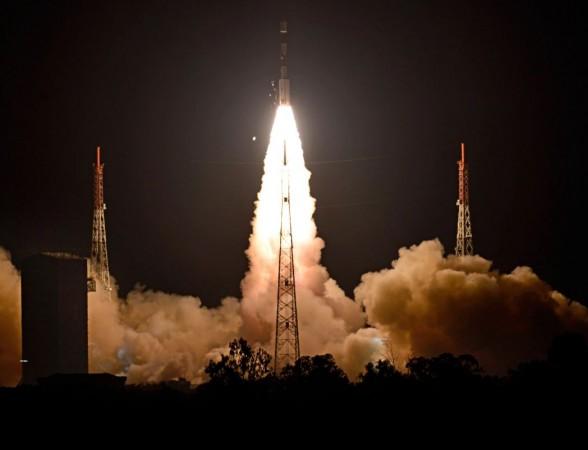- ISRO launched the navigation satellite IRNSS-1I from the Satish Dhawan Space Center in Sriharikota
- The satellite, carried by the PSLV-C41 lifted off at 4.04 am IST
- This is ISRO's second attempt at sending a replacement satellite for the IRNSS-1A
- The satellite was put into the orbit 19 minutes and 19 seconds after the lift off
- The IRNSS-1I satellite has been placed in the geosynchronous orbit at a fixed location and will travel along with the Earth.
The Indian Space Research Organization launched navigation satellite IRNSS-1I Thursday, April 12. The satellite, carried by the PSLV-C41, blasted off the first launch pad of the Satish Dhawan Space Center in Sriharikota, Andhra Pradesh at 4.04 am IST.
"India's Polar Satellite Launch Vehicle, in its forty-third flight (PSLV-C41) in XL configuration will launch IRNSS-1I Satellite from First Launch Pad (FLP) of SDSC (Satish Dhawan Space Centre), Sriharikota," ISRO said in a statement.

The launch was ISRO's second attempt at sending a replacement satellite for the IRNSS-1A, which was launched July 1, 2013, but was rendered ineffective after its three rubidium atomic clocks failed. After the atomic clocks' failure, ISRO had attempted to send another replacement satellite in the form of IRNSS-1H August 2017, but the mission failed as the heat shield that covered the satellite couldn't separate.
Watch the lift off of the PSLV-C41/IRNSS-1I
The 32-hour countdown for the launch began at 8:04 pm April 10, and ISRO also released a curtain raiser of the same.
What is IRNSS?
IRNSS stands for Indian Regional Navigation Satellite System. It is a set of satellites that provides accurate real-time positioning and timing services and works in a similar manner as the GPS.
As of now, there are seven IRNSS satellites in the orbit labeled as 1A to 1G. These satellites are placed in the geosynchronous orbit at a fixed location and travel along with the Earth.
These satellites aid in land, air and marine navigation. They also help in time-keeping and disaster management.
PSLV-C41/IRNSS-1I mission fact file
▪ The IRNSS-1I was carried by the Polar Satellite Launch Vehicle (PSLV) C-41, which blasted off from Sriharikota.
▪ This was the PSLV's 43rd flight and the 20th flight of PSLV-XL version.
▪ Thursday's launch was the 32nd launch of the PSLV from the first launch pad of the Satish Dhawan Space Center.
▪ The PSLV put the satellite into the orbit 19 minutes and 19 seconds after lift-off.
▪ It weighs 1,425 kg at lift-off and will carry two payloads – navigation and ranging.
▪ While the navigation payload will transmit signals and help determine time, position, and velocity, the ranging payload will determine the satellite's frequency range.
▪ The IRNSS-1I's closest point will be 284 km above the Earth and it will be farthest at 20,650 km above the Earth.
▪ Its overall size is measured at 1.58m x 1.5m x 1.5m and has a power of 1,670W.
▪ The IRNSS-1I has been built by a consortium of firms led by Bengaluru-based aerospace firm Alpha Design Technologies in collaboration with ISRO, reported the Economic Times.
While India has made commendable strides when it comes to its GPS satellite systems, it is not the first. The United States and Russia have functional GPS satellite systems.
The US was the first country to introduce satellite technology with GPS. Its satellite network, Navstar, offers navigation and tracking technology, including location, and time across the world. The GPS satellites orbit the Earth every 12 hours and are used by the armed forces, as well as, the civilians. First launched in February 1978, it has a total of 33 satellites, out of which 31 are placed in the orbit.
Russia's Glonass is the second navigational system in operation and has a global coverage. The Glonass is a network of 27 satellites, out of which 24 are already in the orbit. It was first launched in October 1982 and is used by the military and civilians.
The launch of IRNSS-1I comes days after ISRO launched the GSAT-6A communication satellite. The satellite lifted off from the second launch pad of the Satish Dhawan Space Centre, Sriharikota, March 29. While this was considered to be quite a feat for ISRO, the organization lost contact with the GSAT-6A 48 hours later.
ISRO then said that it was trying to re-establish contact with the satellite and chief K Sivan explained that losing contact with a satellite was a "common phenomenon" and the organization still hopes to get back in contact with the GSAT-6A.
"Our team is trying to re-establish the communication link with the satellite. Though the delinking of signal from a satellite is a common phenomenon, this time the signal delinking is happening for a longer duration," Sivan had at the times told the Times of India.

















